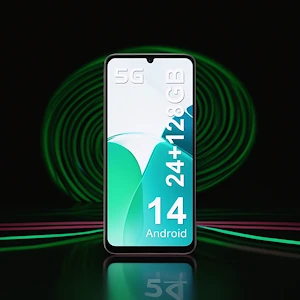The Fossibot F11: A Chunky Workhorse That Plays the Long Game
Let me start by saying this phone feels like a pickup truck in a world of sports cars. At 18.5mm thick and 380 grams, the F11 has heft – the kind you notice when it’s in your pocket. But that bulk isn’t just for show. There’s a 4,900mAh battery crammed in there, and let me tell you, this thing lasts. During my testing, it pulled two full days of moderate use – streaming, scrolling, and even some light gaming – without breaking a sweat. The tradeoff? That 10W charging feels glacial compared to today’s 30W+ standards. You’ll want to plug it in overnight.
The Screen Dilemma: Smooth vs Sharp
That 6.74” LCD screen is… interesting. The 120Hz refresh rate makes TikTok scrolling buttery smooth, but the 720p resolution on such a large panel had me squinting at text sometimes. It’s like watching a DVD on a 65” TV – serviceable, but you see the pixels. Outdoor visibility is decent at 480 nits (about as bright as a cloudy day sky), though direct sunlight still causes glare. The water-drop notch feels dated in 2025, but hey – it leaves room for decent stereo speakers that actually get loud enough for podcast listening in the shower.
Performance – Where Compromises Bite
MediaTek’s Dimensity 6100+ chip is the equivalent of a reliable four-cylinder engine – it’ll get you there, but don’t expect to win any races. Casual apps run fine, but I noticed stutters when switching between Google Maps and Spotify while navigating. Gaming? Forget Genshin Impact on high settings. The Mali-G57 GPU chokes on anything beyond casual games like Candy Crush. That 6GB RAM is the real bottleneck here – apps reload constantly if you’re the type to have 15 Chrome tabs open.
The Camera That Exists
Let’s be real – the 50MP main shooter is there to check a marketing box. In decent light, photos are passable for Instagram stories. But that tiny 1/2.55” sensor struggles with dynamic range – sunset shots either blow out the sky or turn foregrounds into silhouettes. The 8MP ultra-wide is softer than a Instagram filter, and the 2MP macro is about as useful as a chocolate teapot. Video stabilization? Non-existent. But the selfie cam surprised me – that 8MP sensor actually handles skin tones better than some flagships I’ve tested.
Built Like a Tank (Literally)
Here’s where Fossibot flexes. The IP68 rating means I literally washed mud off this thing under a faucet. The polycarbonate back survived multiple waist-high drops onto concrete. There’s no case needed here – it’s like they built the case into the phone. Bonus points for keeping the headphone jack and SD card slot – rare finds in 2025.
Who’s This For?
- YES if: You’re a construction worker who needs a phone that survives job sites
- YES if: You’re a road warrior who prioritizes battery life over everything
- NO if: You care about photography or flagship performance
- NO if: You want something sleek for dress slacks
My Personal Take
At €199, this is a phenomenal backup phone or a primary device for the accident-prone. I’d buy it for my kayaking trips where my Galaxy Ultra stays home. But as a daily driver? The chunky design and mediocre performance would wear on me. Still, there’s charm in its no-nonsense approach – like a reliable wrench in a toolbox full of fragile laser levels.
The real magic? Fossibot included full Google Services – rare for Chinese brands these days. That alone makes it more usable than most rugged phones twice its price. Just don’t expect it to be something it’s not. This isn’t a Lamborghini. It’s a Toyota Hilux – unglamorous, unbreakable, and utterly practical.
